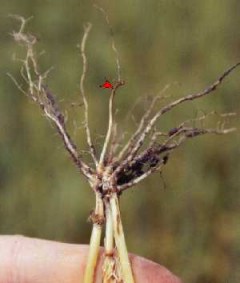Common Root Rot In Wheat, Barley And Oats
Common root rot is a serious disease of wheat, barley, and oats. Infected plants tend to produce fewer tillers with smaller and fewer seeds per head.
Host Crops
Wheat, barley, oats, rye and triticale
Biology
This disease is caused by a complex of soil-borne fungi. The spores germinate in the soil. Seedlings become infected following germination. Spores are produced on diseased tissue and are spread by wind, water, cultivation, and infected seeds. Further infections continue throughout the growing season with new spores being produced on plant parts as they mature. Spores may remain viable in the soil for several years.
Abiotic stresses can favour infection and increase the severity of the damage:
- Drought and warm weather cause more severe infections.
- Nutritional stress can favour infection.
- Soil compaction that restricts root growth and by over-applications of nitrogen under moisture stress conditions can also favour infection.

Symptoms of Damage
Patchy emergence is usually the first indication that damage has occurred. Infections start on the roots and sub-crown internodes and move to the leaves. Seedlings may die before or soon after emergence even though they only show slight damage.
In general, symptoms include damping off (sudden death) of emerging seedlings, stunted chlorotic growth, reduced root growth and decay of the crown area. Severe infections can abort tillers. A darkening or reddish-brown decay often occurs in the sub-crown internode between the crown and second or third node.
Scouting Techniques
Early detection is required for proper diagnosis. Pull up plants and examine the crowns and subcrown internodes for disease. Look for brown discolouration of stem bases, roots, crowns, and lower leaf sheaths. Infected plants are generally shorter and produce fewer stems and grains per head. At times, plants appear bleached and dead.
Economic Thresholds
None available.
Control Tips
- Avoid soil compaction. Turning under stubble may help to reduce infection levels. Apply adequate nitrogen, phosphorus and potassium to encourage vigorous root and shoot growth to enable plants to resist or tolerate infection.
- Seed into warm, well-drained soils at proper seeding depths (3-4 cm) promotes uniform germination and emergence which will reduce infection. Avoid growing continuous wheat or continuous barley. Rotation with non-cereal crops and control of grassy weeds will reduce inoculum levels.
- Commercial seed treatment fungicides that prevent seed decay also provide some protection against post-emergence infections. Consult the Guide to Field Crop Protection for more information.

